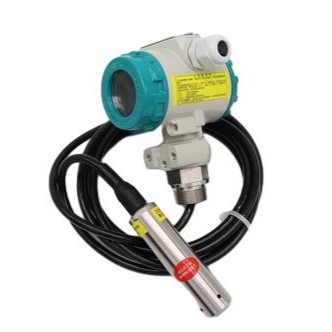What to pay attention to during the application of drop level meter
2023-12-27
A drop level gauge is an instrument used to measure the level of a liquid (or material such as a solid powder). It is usually done by embedding a sensor or measuring device into the liquid being measured in order to monitor the level height in real time. This level gauge can be placed directly in the liquid, in direct contact with the measured medium, without the need for external installation or piping connections. The following points need to be noted during the application of the input level gauge:

1. Understanding of the properties of the medium: Ensure that the properties of the measured medium are understood, including temperature, pressure, chemical properties, etc. Choose the right material and model to ensure the stability and durability of the level meter.
2. Correct installation position: When installing the liquid level gauge, select the right position to ensure the accuracy of the measurement. Avoid installation in areas that may be stirred or fluctuated by liquids to prevent errors.
3. Calibration and debugging: Before putting into use, carefully calibrate and debug. Ensure that the zero and full position calibration of the liquid level gauge is accurate to improve the accuracy of the measurement.
4. Anti-corrosion and anti-pollution: For some corrosive or easily polluted media, choose corrosion-resistant materials and take corresponding measures, such as adding anti-corrosion layer or regular cleaning, to extend the service life of the level meter.
5. Avoid bubbles and bubbles: The accuracy of the level gauge may be affected by bubbles or bubbles. Ensure that there are no air bubbles in the liquid and take appropriate measures to prevent the formation of bubbles.
6. Regular maintenance: Regular maintenance and inspection are carried out to ensure the normal operation of the level gauge. Clean the surface of the sensor, check that the cable connection is firm, and prevent failures caused by corrosion or wear.
7. Safety considerations: When using an input level gauge, safety factors should be considered. Ensure equipment complies with relevant safety standards and follows correct safe operating procedures.
8. Environmental conditions: Consider the impact of ambient conditions on the level gauge, such as temperature changes, humidity, vibration, etc. Select the type of level gauge suitable for specific environmental conditions.
9. Reasonable use: Avoid exceeding the rated working range of the liquid level gauge to prevent damage to the equipment or inaccurate measurement results.
10. Training personnel: Ensure that the operators using the level meter have received relevant training to understand the normal operation of the equipment and the handling methods in case of emergency.
Aister Instrument focuses on the production and development of flow meters, welcome to contact us online or by phone.

1. Understanding of the properties of the medium: Ensure that the properties of the measured medium are understood, including temperature, pressure, chemical properties, etc. Choose the right material and model to ensure the stability and durability of the level meter.
2. Correct installation position: When installing the liquid level gauge, select the right position to ensure the accuracy of the measurement. Avoid installation in areas that may be stirred or fluctuated by liquids to prevent errors.
3. Calibration and debugging: Before putting into use, carefully calibrate and debug. Ensure that the zero and full position calibration of the liquid level gauge is accurate to improve the accuracy of the measurement.
4. Anti-corrosion and anti-pollution: For some corrosive or easily polluted media, choose corrosion-resistant materials and take corresponding measures, such as adding anti-corrosion layer or regular cleaning, to extend the service life of the level meter.
5. Avoid bubbles and bubbles: The accuracy of the level gauge may be affected by bubbles or bubbles. Ensure that there are no air bubbles in the liquid and take appropriate measures to prevent the formation of bubbles.
6. Regular maintenance: Regular maintenance and inspection are carried out to ensure the normal operation of the level gauge. Clean the surface of the sensor, check that the cable connection is firm, and prevent failures caused by corrosion or wear.
7. Safety considerations: When using an input level gauge, safety factors should be considered. Ensure equipment complies with relevant safety standards and follows correct safe operating procedures.
8. Environmental conditions: Consider the impact of ambient conditions on the level gauge, such as temperature changes, humidity, vibration, etc. Select the type of level gauge suitable for specific environmental conditions.
9. Reasonable use: Avoid exceeding the rated working range of the liquid level gauge to prevent damage to the equipment or inaccurate measurement results.
10. Training personnel: Ensure that the operators using the level meter have received relevant training to understand the normal operation of the equipment and the handling methods in case of emergency.
Aister Instrument focuses on the production and development of flow meters, welcome to contact us online or by phone.
Share To:
News
- Why is the thermal gas mass flowmeter not affected by pressure strength and temperature?
- What to do when a thermal gas mass flow meter fails?
- How are thermal gas mass flow meters used? What are the applications?
- Under what circumstances is the gas measurement need to be regulated compensated vortex flowmeter
- Why Is The Aister Thermal Gas Mass Flowmeter So Popular ?
- Gas turbine flowmeter manufacturers explain their main advantages in measurement
- Gas turbine flowmeter manufacturer Aister instrument field experience summary
- Aister Instrument Empowerment Conference








